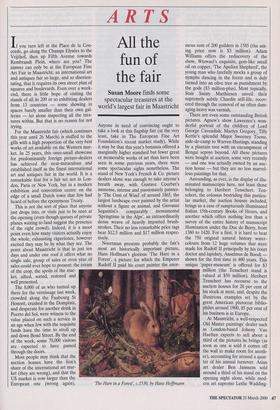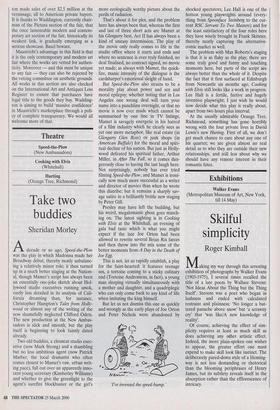ARTS
All the fun of the fair
Susan Moore finds some spectacular treasures at the world's largest fair in Maastricht
If you turn left at the Place de la Con- corde, go along the Champs Elysees to the Vrijthof, then up Fifth Avenue towards Rembrandt Plein, where are you? The answer can only be at the European Fine Art Fair in Maastricht, an international art and antiques fair so large, and so disorien- tating, that it requires its own street plan of squares and boulevards. Even over a week- end, there is little hope of visiting the stands of all its 200 or so exhibiting dealers from 13 countries — some showing in spaces barely smaller than their own gal- leries — let alone inspecting all the trea- sures within. But that is no reason for not trying. For the Maastricht fair (which continues this year until 26 March) is stuffed to the gills with a high proportion of the very best works of art available on the Western mar- ket. In 25 years, this once-small showcase for predominantly foreign picture-dealers has achieved the near-miraculous and established itself as the finest international art and antiques fair in the world. It is a remarkable feat for a fair set not in Lon- don, Paris or New York, but in a modern exhibition and convention centre on the edge of a small Dutch town that few had heard of before the eponymous Treaty.
This is not the sort of place that anyone just drops into, or visits just to be seen at the opening (even though queues of private planes waiting to land suggest the presence of the right crowd). Indeed, it is a moot point even how many visitors actually enjoy the whole, exhausting experience, however excited they may be by what they see. The point about Maastricht is that in just ten days and under one roof it offers what no single sale, group of sales or even year of sales could ever hope to present: the cream of the crop, the spoils of the mar- ket, sifted, sorted, restored and well presented. The 8,000 of us who turned up there for the vernissage last week, crowded along the Faubourg St Honore, crushed in the Domplatz, and desperate for another drink in Puerto del Sol, were witness to the value placed on such a service in an age when few with the requisite funds have the time to stroll up and down Bond Street. By the end of the week, some 70,000 visitors are expected to have passed through the doors. Most people may think that the auction houses have the lion's share of the international art mar- ket (they are wrong), and that the US market is now larger than the European one (wrong again). Anyone in need of convincing ought to take a look at this flagship fair (at the very least, take in The European Fine Art Foundation's recent market study). While it may be that this year's bonanza offered a marginally higher standard but fewer great or memorable works of art than have been seen in some previous years, there were some spectacular sights nonetheless. The stand of New York's French & Co. picture dealers alone was enough to take anyone's breath away, with Gustave Courbet's immense, intense and passionately painter- ly 'The Gust of Wind' of around 1865, the largest landscape ever painted by the artist without a figure or animal, and Giovanni Segantini's comparably monumental 'Springtime in the Alps', an extraordinarily dense weave of heavily impasted brush- strokes. Their no less remarkable price tags bear $12.5 million and $17 million respec- tively.
Noortman presents probably the fair's most art historically important picture, Hans Hofftnan's glorious 'The Hare in a Forest', a picture for which the Emperor Rudolf II paid his court painter the enor- The Hare in a Forest', c.1530, by Hans Hoffmann mous sum of 200 guilders in 1585 (the ask- ing price now is $3 million). Adam Williams offers the rediscovery of the show, Wtewael's exquisite, gem-like small oil on copper, 'The Apulian Shepherd', the young man who fatefully mocks a group of nymphs dancing in the forest and is duly turned into an olive tree as punishment by the gods ($3 million-plus). Most topically, Stair Sainty Matthiesen unveil their supremely subtle Chardin still-life, recov- ered through the removal of an often dam- aging heavy wax varnish.
There are even some outstanding British pictures. Agnew's show Lawrence's won- derful portrait of the children of Lord George Cavendish; Martyn Gregory, Tilly Kettle's splendid Major Sweeney Toone, aide-de-camp to Warren Hastings, standing by a plantain tree with an encampment of Bengal sepoys beyond. All these pictures were bought at auction, some very recently — and one was actually owned by an auc- tion house — but they are no less marvel- lous paintings for that.
Astounding, as ever, is the display of illu- minated manuscripts here, not least those belonging to Heribert Tenschert. Ten- schert, the colossus bestriding this particu- lar market, the auction houses included, brings us a case of sumptuously illuminated Italian 15th-century Books of Hours, and another which offers nothing less than a survey of the entire history of manuscript illumination under the Due de Berry, from 1380 to 1420. For a first, it is hard to beat the 750 original natural history water- colours from 12 huge volumes that were made for Rudolf II principally by his court doctor and lapidary, Anselmus de Boodt — shown for the first time in 400 years. This unique 'paper-museum' is offered for $3 million (the Tenschert stand is valued at $50 million). Heribert Tenschert has recourse to the auction houses for 20 per cent of his stock at most, and, despite the illustrious examples set by the great American plutocrat biblio- philes around 1900, 85 per cent of his business is in Europe.
At Maastricht, a well-respected Old Master paintings' dealer such as London-based Johnny Van Haeften expects to sell about a third of the pictures he brings (as soon as one is sold it comes off the wall to make room for anoth- er), accounting for around a quar- ter of his annual turnover. Asian art dealer Ben Janssens sold around a third of his stand on the opening night alone, while mod- ern art supremo Leslie Wadding- ton made sales of over $2.5 million at the vemissage, all to American private buyers. It is thanks to Waddington, currently chair- man of the Pictura section of the fair, that the once lamentable modern and contem- porary art section of the fair, historically its weakest link, is gradually emerging as a serious showcase. Basel beware.
Maastricht's advantage in this field is that it is the only contemporary and modern art fair where the works are vetted for authen- ticity. Moreover — and this must be unique to any fair — they can also be rejected by the vetting committee on aesthetic grounds. All works in this section are also checked on the International Art and Antiques Loss Register to ensure that purchasers have legal title to the goods they buy. Wadding- ton is aiming to build 'massive confidence' in Maastricht's marketplace through a poli- cy of complete transparency. We would all welcome more of that.



































































 Previous page
Previous page